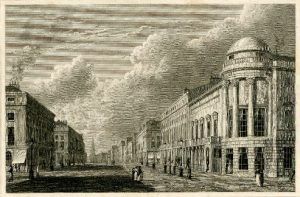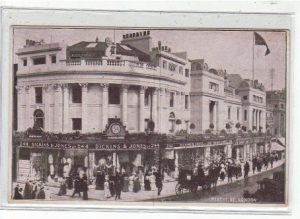L’Argyll Rooms: la breve esperienza di un piccolo teatro londinese.

La storia dell’Argyll Rooms comincia nel 1806, quando l’imprenditore Henry Francis Greville acquista un’abitazione in Little Argyll Strett (più tardi annessa a Regent Street). Greville adibisce l’edificio all’intrattenimento per il pubblico e, nel 1807, ottiene dal Lord Chamberlain la licenza per mettere in scena all’Argyll Rooms.
Gli spazi di questo teatro vengono animati da musica, pièce teatrali, per lo più scherzose, e da balli in maschera. I critici dell’epoca hanno parole poco lusinghiere nei confronti del teatro che secondo William Taylor, direttore del Kings’s Theater a Londra, non aveva nemmeno dei palcoscenici veri e propri e era caratterizzato da messe in scena scadenti e da una generale mancanza di organizzazione. Lo stesso Lord Byron dedicherà a Greville e alla clientela dell’Argyll Rooms alcune rime sprezzanti.
Nel 1811, malato e oppresso dai debiti, Greville lascia l’Inghilterra, affidando la gestione dell’Argyll Rooms a Stephen Slade, uno degli soci del teatro; quando Greville muore, nel 1816, Slade ne diventa il proprietario. È sotto la gestione di Stephen Slade che l’Argyll Rooms ottiene celebrità e successo.
La fortuna dell’Argyll Rooms comincia nel 1813, quando diventa la location principale dei concerti tenuti dalla neonata Philharmonic Society, la quale continuerà ad esibirsi all’Argyll Rooms fino al 1830.
Nel 1818 l’Argyll Rooms risulta ben diverso da quello che Greville ha lasciato anni prima. La critica descrive con parole di apprezzamento gli interni ricchi e ben curati del teatro, i suoi tendaggi raffinati, le lussuose decorazioni e l’ottima illuminazione degli spazi, dove vengono messe in scena rappresentazioni teatrali, balli e feste in maschera.
Nel 1819, dopo anni di insistenze, Slade è costretto a vendere l’Argyll Rooms ai New Street Commitioners, gli addetti al progetto per la costruzione di Regent Street. Il progetto, curato dall’architetto urbanista John Nash, prevede l’alterazione della struttura del teatro al fine di poterlo inserire nel piano della nuova strada . I New Street Commitioners affidano la gestione dell’Argyll Rooms alla Regent’s Society, una società che promuoveva musica e composizione e che agiva sotto il patronato del principe Reggente, George IV; qualche anno dopo la società prenderà il nome di Royal, Harmonic Institution.
Quando nell’autunno del 1819 iniziano i lavori di ristrutturazione dell’Argyll Rooms, il tetto dell’edificio crolla e l’edificio deve venire demolito interamente. È lo stesso John Nash che elabora il piano di ricostruzione del teatro, riorganizzandone gli spazi, creando un’amplia sala concerti, una saletta per concerti più informale e una sala per banchetti e incontri. Il nuovo Argyll Rooms si apre su Regent Street attraverso una grande hall dove troneggia un’imponente scalinata. Il piano terra viene adibito a negozio per la Royal, Harmonic Institution, mentre i piani superiori vengono dedicati all’intrattenimento. La facciata appare decorata da colonne con capitelli corinzi, balaustre e balconate ricche di ornamenti; gli interni sono altrettanto sfarzosi. Il nuovo teatro è un esempio di bellezza e lusso, una perla al centro della strada dedicata al principe Reggente.
Nel corso degli anni ’20 per le sale dell’Argyll Rooms passano alcuni dei nomi più importanti della produzione musicale del 1800, come Liszt, Mendelssohn e Weber. Il teatro non è però solo sede di concerti, ma anche di opere teatrali, balli e addirittura lezioni di astronomia.
Nel 1822 gli affari della Royal, Harmonic Institution sono in declino e gli ultimi soci rimasti sono Thomas Welsh and William Hawe, che ipotecano l’Argyll Rooms al banchiere Rowland Stephenson. Quando Hawe dichiara bancarotta, nel 1828, Welsh rimane il solo proprietario del teatro.

La fine dell’Argyll Rooms arriva inaspettata e inesorabile: viene distrutto completamente da un incendio nel Febbraio 1830. In seguito a questo incidente costruire un nuovo teatro appare un investimento troppo rischioso. Dove un tempo sorgeva l’Argyll Rooms Welsh fa erigere un gruppo di case, che saranno poi occupate dal grande magazzino Dickins & Jones.
Sitografia:
https://www.british-history.ac.uk/survey-london/vols31-2/pt2/pp284-307#h3-0014 “Survey of London: Volumes 31 and 32, St James Westminster, Part 2” [Ultima consultazione 09/01/2020]
http://www.arthurlloyd.co.uk/TrocaderoLeicesterSquareLondon.htm#Argyll “The London Trocadero, Leicester Square and Piccadilly Circus” [Ultima consultazione 09/01/2020]
ENGLISH VERSION.
Argyll Rooms, Regent Street
Argyll Rooms: the short experience of a little Londoner theater.
Argyll Rooms’ history started in 1896, when the entrepreneur Henry Francis Greville bought a dwelling in Little Agryll Street (later linked with Regent Street). Greville assigned the building to public entertainment and, in 1807, he obtained from Lord Chamberlain the license to stage performances at Argyll Rooms.
The theater was animated by music, theatrical pièce, mostly jocular, and masked balls. Critics of the time made negative comments towards Argyll Rooms, which was regarded by William Taylor, the King’s Theater’s director in London, as lacking of real and significant stages, characterized by low quality and a general disorganization. Lord Byron himself addressed to Greville and Argyll Room’ s audience some scornful words.
In 1811 Greville was sick and oppressed by debts, so he left England leaving the direction of Argyll Rooms to Stephen Blade. When Greville died in 1816, Slade became the theater’s owner, and thanks to his management the Argyll Rooms obtained fame and success.
Argyll Rooms’ fortune started in 1813, when it became the main location for the concerts made by the newborn Philharmonic Society, which continued to perform at Argyll Rooms until 1830.
In 1818 Argyll Rooms appeared very different from the one left by Greville years ago. Critics described with positive words the rich and well-kept theater’s interiors, its refined curtains, luxurious decorations and excellent illumination of the space, where theatrical performances, balls and masked parties took place.
In 1819, after several years of demanding requests, Slade was forced to sell Argyll Rooms to New Street Commitioners, who were the operators in charge of the construction Regent Street. The project, handled by the urban architect John Nash, required the theater structure’s alteration in order to include the Argyll Rooms into the new street design. The New Street Commitioners entrusted the Argyll Rooms management to the Regent Society, which promoted music and composition. This society served under the George IV’s tutelage; a few years later the society would be called Royal Harmonic Institution.
In the autumn of 1819, the roof fell and the building had to be demolished completely. John Nash elaborated the theater’s rebuilding plan and reorganized the inner space. He assigned a large hall to concerts, a little room to more informal shows, and then allocated another hall to banquets and meetings. From that moment on the new Argyll Rooms opened up on Regent Street through a large hall where a majestic staircase stood out. The ground floor became a shop for the Royal Harmonic Institution, while the upper floors were assigned to entertainment. The façade was decorated with columns enriched in Corinthian capitals, balustrades and balconies full of ornaments, and the interiors were as much splendid. The new theater was an example of beauty and luxury, a rare gem at the center of the street devoted to the Prince Regent.
During the ‘20s important personalities of music world, such as Liszt, Mendelssohn and Weber passed through the Argyll Rooms halls. The theater was not only the location of concerts, but also for theatrical performances, balls and even astronomy lessons.
In 1822 the business of Royal Harmonic Institution was in decline and the last partners left were Thomas Welsh and William Hawe, who mortgaged Argyll Rooms to the banker Rowland Stephenson. When Stephenson declared bankrupt, in 1828, Welsh remained the only owner of the theater.
The end for the Argyll Theater came relentlessly and unexpectedly: it was completely destroyed by a fire in February 1830. After this incident, building a new theater seemed to be too expensive. Thus, Welsh ordered to build a bunch of houses where once Argyll Rooms stood, those houses were right right after occupied by the large warehouse Dickins & Jones.
